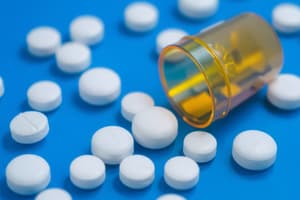Podcast
Questions and Answers
What are the classifications of Quetiapine (Seroquel)?
What are the classifications of Quetiapine (Seroquel)?
- Antidepressants
- Antipsychotics (correct)
- Mood Stabilizers (correct)
- Stimulants
What is the primary action of Quetiapine?
What is the primary action of Quetiapine?
It acts as an antagonist of dopamine and serotonin.
The recommended initial dosage of Quetiapine for adults with schizophrenia is ___ mg twice daily on Day 1.
The recommended initial dosage of Quetiapine for adults with schizophrenia is ___ mg twice daily on Day 1.
25
Quetiapine may be used to treat acute manic episodes associated with ____.
Quetiapine may be used to treat acute manic episodes associated with ____.
Which of the following are some side effects of Quetiapine?
Which of the following are some side effects of Quetiapine?
Quetiapine has listed toxic symptoms.
Quetiapine has listed toxic symptoms.
What should be monitored during Quetiapine therapy?
What should be monitored during Quetiapine therapy?
Study Notes
Quetiapine (Seroquel) Overview
- Classification: Antipsychotics and mood stabilizers, utilized for their therapeutic properties.
Mechanism of Action
- Functions as an antagonist for dopamine and serotonin receptors.
- Also antagonizes histamine H₁ receptors and alpha₁-adrenergic receptors.
- Therapeutic Effects: Reduces symptoms of psychosis, depression, and acute mania.
Dosage and Routes
-
Schizophrenia:
- Adults: Initial 25 mg twice daily, increase to 300-400 mg/day by Day 4 (max 800 mg).
- Children (13-17 yr): Start with 25 mg twice daily, adjusting to a maximum of 800 mg.
-
Acute Manic Episodes (Bipolar I Disorder):
- Adults: Start with 50 mg twice daily, possible increase to 400 mg twice daily.
- Children (10-17 yr): Begin at 25 mg twice daily, can increase to a max of 600 mg.
-
Acute Depressive Episodes (Bipolar Disorder):
- Adults: Start with 50 mg at bedtime, increase up to 300 mg daily.
-
Maintenance Treatment (Bipolar I Disorder):
- Adults: Typical dosage ranges from 400-800 mg/day.
Indications
- Treatment of schizophrenia and bipolar disorder.
- Manages depressive episodes associated with bipolar disorder.
- Adjunctive treatment for major depression.
Side Effects
- CNS: Risks include neuroleptic malignant syndrome, seizures, dizziness, sedation, and tardive dyskinesia.
- EENT: Can cause ear pain and respiratory issues like cough.
- CV: May lead to increased blood pressure, palpitations, and peripheral edema.
- GI: Possible pancreatitis, constipation, and dry mouth.
- Metabolic: Weight gain and risk for hyperglycemia and hyperlipidemia.
- Diseases like Stevens-Johnson syndrome and flu-like syndrome noted as misc.
Toxicity
- No specific toxicity symptoms have been documented.
Nursing Implications
- Regularly assess mental status, weight, and blood pressure.
- Monitor for suicidal tendencies, particularly in the early stages of therapy.
- Ensure the safe administration of the drug to prevent hoarding.
- Watch for extrapyramidal side effects; consider using trihexyphenidyl or benztropine for control.
- Tardive dyskinesia symptoms require immediate reporting due to potential irreversibility.
Studying That Suits You
Use AI to generate personalized quizzes and flashcards to suit your learning preferences.
Description
Explore the therapeutic uses, mechanism of action, and detailed dosage guidelines for Quetiapine (Seroquel). This quiz covers its application in schizophrenia, bipolar disorder, and acute depressive episodes. Test your understanding of this important antipsychotic medication.



